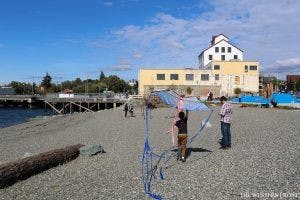Around 19-acres of land are available for redevelopment on Bellingham's waterfront. // Photo by Kelly Pearce
Zoe DealWaves lap gently against the rocky beach of Waypoint Park, accompanied by the steady beating of rain. The clouds overhead stretch thick for miles. It's mid-September; a couple walking their dog and an older man skipping rocks are the sole visitors of Bellingham's newest park.
The park is the first tangible result of years of planning and one of many future parks to be housed amongst 19 acres of multi-use developments over the next 50 years.
Since the finalization of the Waterfront District Sub-Area Plan in 2013, opportunities for public reassessment have been few and far between.
The Sub-Area Plan, also known as the Master Plan, holds the future of the entire waterfront.
Now that the planning stage is over, the cohesion of the waterfront district has been placed in the hands of master developer Harcourt Developments, a property company based in Ireland.
The master developer has exclusive rights to 19 acres at the waterfront. The land, according to Bellingham Port Commissioner Michael Shepard, is the most buildable acreage on the north side.
In this stage, community involvement has waned as what Bellingham business owner John Blethen calls feelings of “idealistic” anticipation have decayed into a subdued excitement.
“Almost none of us that started this process are still engaged in it,” said Blethen, who was a member of the Waterfront Advisory Group in the late 2000s. “[There was a] huge amount of public interest in this initially, but a lot of it died.”
When asked why, after over 10 years of involvement, Blethen and others chose to depart from the project, Blethen responded, “How many years can you beat your head against the wall?”
Blethen said his primary frustration was that the project was interrupted at every stage as it went through the Planning Commission, City Council, City, Port, etc.
Mason Luvera, communications director at the Downtown Bellingham Partnership, said the partnership is running into a “pervasive” lack of awareness and engagement in the broader community regarding the waterfront.
“The general consensus amongst most is really a lack of understanding of what that project even is,” he said. “We want to be able to authentically connect the whole community with this insanely exciting future for the city, and it simply isn’t happening.”

The Port and City selected Harcourt in 2008 after putting out a joint request for proposal process for a master developer for those 19 acres, Shepard said.
“They were the only viable bidder, so they were selected,” Shepard said. “What’s unique about the process is not necessarily that they are an international company, but 2008 was at the height of the recession -- most U.S. companies did not have the capacity for a bid of that nature.”
The Port will sell the land to Harcourt on a project-by-project basis until they’ve met their full allotment of 19 acres.
The first sale, finalized in May 2018, was just under two acres for around $1.6 million. The land is planned for mixed use on the ground floor, with four stories of condos above, Shepard said.
The Granary Building on West Chestnut Street is Harcourt’s current project, which is set to be completed late this year or early in 2019, said Rob Fix, executive director of the Port of Bellingham. The project will include a restaurant, deck and annex, along with office space.
Future Harcourt projects include three residential structures, an office building over structured parking and a hotel alongside the rehabbed Board Mill Building, Fix revealed at the Waypoint Park opening celebration.
Since they own the land and the buildings, Harcourt will dictate who to enter lease agreements with.
Many in the community question why an international developer was permitted to have such control over the future of the waterfront.
“The first thing [the community] wanted was for the public to continue to own the property on long term lease,” Blethen said. “That went by the wayside almost immediately.”
Development companies regularly have this amount of power when a municipality chooses to sell off land. If the Port and City had instead opted to hold ownership of the land, they would be responsible for finding tenants among other roles. The City and Port seem confident about Harcourt’s abilities to cater to the shifting demographic of Bellingham.
“A developer was identified, and we have every intention of watching that developer be successful,” Shepard said.
Luvera mentioned his concern about whether the City and Port are developing the waterfront with placemaking in mind.
“Creating that sense of place is probably the most important element in making any development fit into a community," Luvera said. "I worry that we are not taking a strategic direction to do that.”
Another community concern is why, after 10 years, Harcourt has yet to bring any project to fruition.
Shepard said the issue lies with elements outside Harcourt’s control. The completion of the roads. which will run through the development area, is the primary barrier.
Working with two municipal governments and a broad range of community interest can be difficult for a developer on such a high-stakes project, Shepard said.
“Not having that history of working in our community is a bit of a learning curve,” Shepard said. “They’re pulled in a lot of competing directions.”
As community interest and involvement wanes, Harcourt’s proposals will go through City and Port approval without significant public input. While this may quicken the process, it could be detrimental to the success of the waterfront redevelopment in the eyes of the community.

Tara Sudin, economic development manager with the Mayor’s Office, said the City is excited for the opportunity to extend the downtown into the waterfront district. The City is using urban villages, or multi-use zoned areas with retail, housing and activities, as a model. The plan is to create more interest and draw the population up instead of out as culture shifts from suburban to urban living. Sudin said that by appealing to this movement, the city is appealing to millenials.
While Bellingham is attracting an increasing number of people from around the region, the economy continues to be at a standstill. The resulting higher cost of living makes it difficult for students without financial security to stick around after graduation.
A 2017 report released by Western’s Center for Economic and Business Research found that Bellingham retains 8 percent fewer graduates of higher education than similar cities with mid-sized universities.
Using data from the U.S. Census American Community Survey, study author and Western MBA student Isabel Vassiliadis discovered additionally that Bellingham wages and the number of residents with a bachelor’s degree were low compared to similar cities across the nation.
“The median household in Bellingham earns roughly $7,000 less than the peer city average ($50,899), which is a significant gap considering their similarity in cost of living,” Vassiliadis said.
“There are plenty of people in Bellingham that have comfortable, secure jobs, who have an established familiar group, own a home, and are really happy with the community as it is,” Luvera said. “But there are plenty of young people who are struggling to attain that very thing, and really don’t see any hope for the future.”
Strategies to appeal to a new demographic have been in place in downtown for a long time, Sudin said. She emphasized that the waterfront renovations are simply an extension of strides being made downtown.
If done right, Luvera said the waterfront could be a great opportunity to push Bellingham’s economy in the right direction. If done wrong, a plot of land bursting with potential could become simply another generic development like Barkley Village, Bellis Fair or Cordata.
Luvera said he hopes the City and Port will find more ways to actively engage the community with the ongoing processes of waterfront redevelopment.
“The waterfront in so many ways can be the flagship of us growing Bellingham into an economically viable city for the long haul,” Luvera said. “But if the community doesn’t see that, and really doesn’t even understand what that project is, you can’t begin to turn that into that flagship. And that’s a missed opportunity.”
When asked to comment, Harcourt failed to respond by the publication deadline.
Western on the Waterfront
Western has been looking to have a presence on the waterfront since 2004, when the Board of Trustees appointed an Academic Waterfront Planning Committee to explore being a part of the proposed redevelopment of the Georgia-Pacific site.
Western’s Board of Trustees handled much of the initial research, which led to a character study outlining how Western’s presence on the waterfront will reflect the open atmosphere of its current campus.
A document developed by the university said, “As the third-largest public university in Washington in terms of enrollment yet the smallest in terms of geographic footprint, expanding to the waterfront provides a unique opportunity to perhaps alleviate some space constraints and to expand capacity and visibility for academic programming.”
A white paper published by Western in September 2016 introduced three phases by which Western will move forward with development on the waterfront, according to the document.
The first phase, a collaborative space called the Technology Development Center, was completed and dedicated in fall 2009. The Center is a 10,000 square foot state-and -federally-funded facility located in a remodeled warehouse across the Whatcom Waterway on F Street.
The space acts to facilitate interdisciplinary collaboration in primarily advanced materials engineering, according to the center webpage, and is shared by Western, Bellingham Technical College, The Bellingham Foundry and the IDEA Institute.
While phase II outlined a plan for multi-purpose facility for conferences and large gatherings, the prospective location is now planned to house a hotel and event center developed by Harcourt.
The university is currently working on phase III, the housing of new academic facilities.
Over the past year, Western has conducted an ideation process with representation from faculty members in various fields. Waterfront prototypes were created by students from Western’s Entrepreneurship & Innovation Studies Program to gauge and incorporate student input, according to the document.
However, the ideation will continue into 2019 due to a previous lack of faculty members from non-STEM fields such as the College of Humanities & Social Sciences, the College of Fine & Performing Arts, Fairhaven College of Interdisciplinary Studies and Woodring College of Education, Paul Cocke, Western’s director of Communications and Marketing, said in an email. Additionally, Associated Students President Millka Solomon has also been invited to participate, Cocke said.
“Given the recent completion of Western’s 2018-2024 Strategic Plan coupled with the growing momentum at the waterfront, including completion of the Granary Building and construction of roadways, parks and a first phase of residential development, we are convinced that now is an opportune time to more clearly define a new future for Western at the Waterfront,” Cocke said.
Cocke said additional details on Western’s future on the waterfront can be expected in spring/summer 2019.





